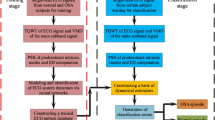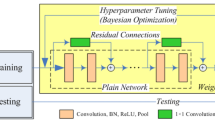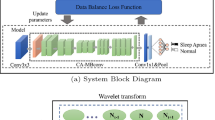Abstract
The sleep apnea is a disease in which there is the absence of airflow during respiration for at least 10 s. It may occur several times during the night sleep. This disease can lead to many types of cardiovascular diseases. To detect this disease, signals obtained from many channels of polysomnography are to be observed visually by physicians for the long duration. This procedure is expensive, time-consuming, and subjective. Hence, it is required to build an automated system to detect the sleep apnea with few channels. This paper uses single-lead electrocardiogram (ECG) signal to detect apneic and non-apneic events. The proposed method uses tunable-Q wavelet transform (TQWT) based filter-bank instead of TQWT to decompose the segment of ECG signal into several constant bandwidth sub-band signals. Then centered correntropies are computed from the various sub-band signals. The obtained features are then fed to the various classifiers to select the optimum performing classifier. In this work, we have obtained the highest classification accuracy, specificity, and sensitivity of 92.78%, 93.91%, and 90.95% respectively using random forest classifier. Hence, our developed prototype is ready for validation with the huge database and clinical usage.






Similar content being viewed by others

References
Acharya UR, Chua EC, Faust O, Lim TC, Lim LF (2011) Automated detection of sleep apnea from electrocardiogram signals using nonlinear parameters. Physiol Meas 32:287–303
Acharya UR, Dua S, Du X, Sree SV, Chua CK (2011) Automated diagnosis of glaucoma using texture and higher order spectra features. IEEE Trans Inf Technol Biomed 15:449–455
Acharya UR, Ng EYK, Eugene LWJ, Noronha KP, Min LC, Nayak KP, Bhandary SV (2015a) Decision support system for the glaucoma using Gabor transformation. Biomed Signal Process Control 15:18–26
Acharya UR, Sudarshan VK, Ghista DN, Lim WJE, Molinari F, Sankaranarayanan M (2015b) Computer aided diagnosis of diabetic subjects by heart rate variability signals using discrete wavelet transform method. Knowl Based Syst 81:56–64
Acharya UR, Fujita H, Lih OS, Hagiwara Y, Tan JH, Adam M (2017a) Automated detection of arrhythmias using different intervals of tachycardia ECG segments with convolutional neural network. Inf Sci 405:81–90
Acharya UR, Fujita H, Oh SL, Hagiwara Y, Tan JH, Adam M (2017b) Application of deep convolutional neural network for automated detection of myocardial infarction using ECG signals. Inf Sci 415–416:190–198
Acharya UR, Oh SL, Hagiwara Y, Tan JH, Adam M, Gertych A, Tan RS (2017c) A deep convolutional neural network model to classify heartbeats. Comput Biol Med 89:389–396
Afkhami RG, Azarnia G, Tinati MA (2016) Cardiac arrhythmia classification using statistical and mixture modeling features of ECG signals. Pattern Recogn Lett 70:45–51
American Academy of Sleep Medicine Task Force (1999) Sleep-related breathing disorders in adults: recommendations for syndrome definition and measurement techniques in clinical research. Sleep 22:667–689
Arqub OA (2017) Adaptation of reproducing kernel algorithm for solving fuzzy Fredholm–Volterra integrodifferential equations. Neural Comput Appl 28:1591–1610
Arqub OA, Abo-Hammour Z (2014) Numerical solution of systems of second-order boundary value problems using continuous genetic algorithm. Inf Sci 279:396–415
Azar AT, El-Said SA (2014) Performance analysis of support vector machines classifiers in breast cancer mammography recognition. Neural Comput Appl 24:1163–1177
Azarbarzin A, Moussavi Z (2013) Snoring sounds variability as a signature of obstructive sleep apnea. Med Eng Phys 35:479–485
Bhattacharyya A, Pachori RB, Acharya UR (2017a) Tunable-Q wavelet transform based multivariate sub-band fuzzy entropy with application to focal EEG signal analysis. Entropy 19:99
Bhattacharyya A, Pachori RB, Upadhyay A, Acharya UR (2017b) Tunable-Q wavelet transform based multiscale entropy measure for automated classification of epileptic EEG signals. Appl Sci 7:385
Box JF (1987) Guinness, gosset, fisher, and small samples. Stat Sci 2:45–52
Breiman L (1996) Bagging predictors. Mach Learn 24:123–140
Breiman L (2001) Random forests. Mach Learn 45:5–32
Chen L, Zhang X, Song C (2015a) An automatic screening approach for obstructive sleep apnea diagnosis based on single-lead electrocardiogram. IEEE Trans Autom Sci Eng 12:106–115
Chen L, Zhang X, Wang H (2015b) An obstructive sleep apnea detection approach using kernel density classification based on single-lead electrocardiogram. J Med Syst 39:47
Faust O, Hagiwara Y, Hong TJ, Lih OS, Acharya UR (2018) Deep learning for healthcare applications based on physiological signals: a review. Comput Methods Programs Biomed 161:1–13
Faust O, Acharya UR, Ng EYK, Fujita H (2016) A review of ECG-Based diagnosis support systems for obstructive sleep apnea. J Mech Med Biol 16:1640004
Fraiwan L, Lweesy K, Khasawneh N, Wenz H, Dickhaus H (2012) Automated sleep stage identification system based on time-frequency analysis of a single EEG channel and random forest classifier. Comput Methods Programs Biomed 108:10–19
Goldberger AL, Amaral LAN, Glass L, Hausdorff JM, Ivanov PC, Mark RG, Mietus JE, Moody GB, Peng CK, Stanley HE (2000) Physiobank, physiotoolkit, and physionet: components of a new research resource for complex physiologic signals. Circulation 101:e215–e220
Hajinoroozi M, Mao Z, Huang Y (2015) Prediction of drivers drowsy and alert states from EEG signals with deep learning. In: Proceedings of IEEE 6th international workshop on computational advances in multi-sensor adaptive processing, pp 493–496
Hall M, Frank E, Holmes G, Pfahringer B, Reutemann P, Witten IH (2009) The WEKA data mining software: an update. SIGKDD Explor 11:10–18
Hassan AR (2015a) A comparative study of various classifiers for automated sleep apnea screening based on single-lead electrocardiogram. In: Proceedings of international conference on electrical electronic engineering, pp 45–48
Hassan AR (2015b) Automatic screening of obstructive sleep apnea from single-lead electrocardiogram. In: Proceedings of international conference on electrical engineering and information communication technology, pp 1–6
Hassan AR (2016) Computer-aided obstructive sleep apnea detection using normal inverse Gaussian parameters and adaptive boosting. Biomed Signal Process Control 29:22–30
Hassan AR, Haque MA (2016) Computer-aided obstructive sleep apnea screening from single-lead electrocardiogram using statistical and spectral features and bootstrap aggregating. Biocybern Biomed Eng 36:256–266
Hassan AR, Haque MA (2017) An expert system for automated identification of obstructive sleep apnea from single-lead ECG using random under sampling boosting. Neurocomputing 235:122–130
Huijse P, Estevez PA, Protopapas P, Zegers P, Principe JC (2012) An information theoretic algorithm for finding periodicities in stellar light curves. IEEE Trans Signal Process 60:5135–5145
Janbakhshi P, Shamsollahi MB (2018) Sleep apnea detection from single-lead ECG using features based on ECG-derived respiration (EDR) signals. IRBM 39:206–218
Javaheri S, Dempsey JA (2013) Central sleep apnea. Compr Physiol 3:141–163
Joshi D, Tripathi A, Sharma R, Pachori RB (2017) Computer aided detection of abnormal EMG signals based on tunable-Q wavelet transform. In: Proceedings of 4th international conference on signal processing and integrated networks, pp 544–549
Kesper K, Canisius S, Penzel T, Ploch T, Cassel W (2012) ECG signal analysis for the assessment of sleep-disordered breathing and sleep pattern. Med Biol Eng Comput 50:135–144
Khandoker AH, Karmakar CK, Palaniswami M (2009) Automated recognition of patients with obstructive sleep apnoea using wavelet-based features of electrocardiogram recordings. Comput Biol Med 39:88–96
Kohavi R (1995) A study of cross-validation and bootstrap for accuracy estimationand model selection. In: Proceedings of the 14th international joint conference on artificial intelligence, pp 1137–1143
Kumar TS, Kanhangad V (2018) Gabor filter-based one-dimensional local phase descriptors for obstructive sleep apnea detection using single-lead ECG. IEEE Sens Lett 2:1–4
Li Y, Luo ML, Li K (2016) A multiwavelet-based time-varying model identification approach for time-frequency analysis of EEG signals. Neurocomputing 193:106–114
Lippmann R (1987) An introduction to computing with neural nets. IEEE ASSP Mag 4:4–22
Lngkvist M, Karlsson L, Loutfi A (2014) A review of unsupervised feature learning and deep learning for time-series modeling. Pattern Recogn Lett 42:11–24
Madyastha RK, Aazhang B (1994) An algorithm for training multilayer perceptrons for data classification and function interpolation. IEEE Trans Circ Syst I Fundam Theory Appl 41:866–875
McKight PE, Najab J (2010) Kruskal-Wallis test. Corsini Encycl Psychol
Mendez MO, Bianchi AM, Matteucci M, Cerutti S, Penzel T (2009) Sleep apnea screening by autoregressive models from a single ECG lead. IEEE Trans Biomed Eng 56:2838–2850
Nguyen HD, Wilkins BA, Cheng Q, Benjamin BA (2014) An online sleep apnea detection method based on recurrence quantification analysis. IEEE J Biomed Health Inf 18:1285–1293
Pachori RB, Nishad A (2016) Cross-terms reduction in the WignerVille distribution using tunable-Q wavelet transform. Sig Process 120:288–304
Patidar S, Pachori RB (2013) Segmentation of cardiac sound signals by removing murmurs using constrained tunable-Q wavelet transform. Biomed Signal Process Control 8:559–567
Patidar S, Pachori RB (2014) Classification of cardiac sound signals using constrained tunable-Q wavelet transform. Expert Syst Appl 41:7161–7170
Patidar S, Pachori RB, Acharya UR (2015a) Automated diagnosis of coronary artery disease using tunable-Q wavelet transform applied on heart rate signals. Knowl-Based Syst 82:1–10
Patidar S, Pachori RB, Garg N (2015b) Automatic diagnosis of septal defects based on tunable-Q wavelet transform of cardiac sound signals. Expert Syst Appl 42:3315–3326
Patidar S, Pachori RB, Upadhyay A, Acharya UR (2017) An integrated alcoholic index using tunable-Q wavelet transform based features extracted from EEG signals for diagnosis of alcoholism. Appl Soft Comput 50:71–78
Peker M (2016) An efficient sleep scoring system based on EEG signal using complex-valued machine learning algorithms. Neurocomputing 207:165–177
Penzel T, Moody GB, Mark RG, Goldberges AL, Peter JH (2000) The apnea-ECG database. Comput Cardiol 27:255–258
Penzel T, McNames J, Chazal P, Raymond B, Murray A, Moody G (2002) Systematic comparison of different algorithms for apnoea detection based on electrocardiogram recordings. Med Biol Eng Comput 40:402–407
Rahhal MMA, Bazi Y, AlHichri H, Alajlan N, Melgani F, Yager RR (2016) Deep learning approach for active classification of electrocardiogram signals. Inf Sci 345:340–354
Rao M, Seth S, Xu J, Chen Y, Tagare H, Prncipe JC (2011) A test of independence based on a generalized correlation function. Sig Process 91:15–27
Reddy GRS, Rao R (2017) Automated identification system for seizure EEG signals using tunable-Q wavelet transform. Eng Sci Technol Int J 20:1486–1493
Santamaria I, Pokharel PP, Principe JC (2006) Generalized correlation function: definition, properties, and application to blind equalization. IEEE Trans Signal Process 54:2187–2197
Schlotthauer G, Persia LED, Larrateguy LD, Milone DH (2014) Screening of obstructive sleep apnea with empirical mode decomposition of pulse oximetry. Med Eng Phys 36:1074–1080
Selesnick IW (2011a) TQWT toolbox guide. Electrical and Computer Engineering Polytechnic Institute of New York University
Selesnick IW (2011b) Wavelet transform with tunable Q-factor. IEEE Trans Signal Process 59:3560–3575
Sharma M, Pachori RB (2017) A novel approach to detect epileptic seizures using a combination of tunable-Q wavelet transform and fractal dimension. J Mech Med Biol 17:1740003
Sharma R, Kumar M, Pachori RB, Acharya UR (2017) Decision support system for focal EEG signals using tunable-Q wavelet transform. J Comput Sci 20:52–60
Song C, Liu K, Zhang X, Chen L, Xian X (2016) An obstructive sleep apnea detection approach using a discriminative hidden Markov model from ECG signals. IEEE Trans Biomed Eng 63:1532–1542
Tripathy RK (2018) Application of intrinsic band function technique for automated detection of sleep apnea using HRV and EDR signals. Biocybern Biomed Eng 38:136–144
Varon C, Caicedo A, Testelmans D, Buyse B, Huffel SV (2015) A novel algorithm for the automatic detection of sleep apnea from single-lead ECG. IEEE Trans Biomed Eng 62:2269–2278
White DP (2006) Sleep apnea. Proc Am Thoracic Soc 3:124–128
Xie B, Minn H (2012) Real-time sleep apnea detection by classifier combination. IEEE Trans Inf Technol Biomed 16:469–477
Young T, Peppard PE, Palta M, Hla KM, Finn L, Morgan B, Skatrud J (1997) Population-based study of sleep-disordered breathing as a risk factor for hypertension. Arch Intern Med 157:1746–1752
Author information
Authors and Affiliations
Corresponding author
Additional information
Publisher’s Note
Springer Nature remains neutral with regard to jurisdictional claims in published maps and institutional affiliations.
Rights and permissions
About this article
Cite this article
Nishad, A., Pachori, R.B. & Acharya, U.R. Application of TQWT based filter-bank for sleep apnea screening using ECG signals. J Ambient Intell Human Comput 15, 893–904 (2024). https://doi.org/10.1007/s12652-018-0867-3
Received:
Accepted:
Published:
Issue Date:
DOI: https://doi.org/10.1007/s12652-018-0867-3



